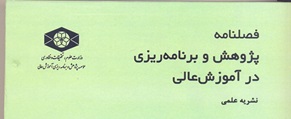بررسی عوامل مؤثر بر میزان تخصیص منابع مالی درون دانشگاهی ایران با استفاده از داده های تابلویی
نویسنده
استادیار دانشکده علوم تربیتی و روانشناسی دانشگاه شهید چمران اهواز، اهواز، ایران
چکیده
سؤال مهم برای برنامهریزان مالی آموزشعالی در سطح کلان این است که الگوی حال حاضر تخصیص منابع به دانشکدهها چگونه است و چه عواملی بر این الگوی تخصیص منابع درون دانشگاهی تأثیر میگذارند. برای پاسخگویی به این سؤال لازم است الگوی تخصیص منابع مالی داخل دانشگاه شناخته شود. هدف این پژوهش شناسایی عواملی بود که بیشترین سهم را در میزان تخصیص منابع مالی به دانشکدهها از سوی دانشگاه- تخصیص درون دانشگاهی- دارند؛ بهعبارتی، هدف پاسخ به این سؤال است که دانشگاهها در سالهای کمبود منابع مالی چه عواملی را در تخصیص منابع مالی به دانشکدهها دخالت میدهند؟ در این پژوهش از روش تحقیق توصیفی از نوع همبستگی با استفاده از مدل رگرسیونی با دادههای طولی- مقطعی استفاده شد. جامعه آماری شامل همه دانشگاههای وابسته به وزارت علوم، تحقیقات و فناوری و نمونه آماری شامل 15 دانشکده و 4 پژوهشکده برای دوره زمانی چهار ساله (76 نمونه) بود. ابزار پژوهش فرم جمعآوری اطلاعات مالی- آموزشی بود که اطلاعات آن از پایگاه اطلاعاتی دانشگاه نمونه جمعآوری شد. بهدلیل کمبود مشاهدات مقطعی، در تحلیل دادهها از روش رگرسیونی دادههای تابلویی (یا پانل) با اثرهای ثابت استفاده شد. در این روشها دادههای سری زمانی با دادههای مقطعی تلفیق میشوند. یافتههای تحقیق نشان داد که متغیر تعداد اعضای هیئت علمی بزرگترین ضریب مثبت را در تابع تخصیص منابع مالی به دانشکدهها دارد. متغیر تعداد دانشجویان معنادار نشد و نشان داد که درون دانشگاه تخصیص منابع مالی بهصورت سرانه انجام نمی-گیرد.
کلیدواژهها
عنوان مقاله [English]
A survey of effective factors on financial resource allocation within Iranian public universities: panel data approach
نویسنده [English]
- Ahmad Saeedi
Assistant Professor, Department of Education, Shahid Chamran University, Ahvaz, Iran
چکیده [English]
A major question for higher education financial planners at macro level is the current pattern of financial resource allocation within colleges and what factors effect on interuniversity financial resource allocation. To answer this question, it is necessary to identify the interuniversity resource allocation pattern. The purpose of present research is to survey and determine the factors that have most contribution on colleges financial resource allocation. In other words, the aim is to answer the question of, what factors do universities consider when they want to allocate financial resource to their colleges in financial scarcely years? In this paper, we utilized descriptive-correlation and regression analysis methods with longitudinal-cross data to analysis resource allocation function. The population was all public universities affiliated to the Ministry of Science, Research and Technology. The sample was 15 colleges and 4 research centers in 4 years’ time period (totally 76 cases). The research instrument was the Financial and Educational Data Form. Because of few colleges in sample, we used panel data approach for regression analysis with fixed effect. In these methods, time series data with cross-sectional data are combined. The result showed that “number of faculty per college” have greatest positive effect on amount of financial resource allocation per college. The “number of students in college” had no significant effect on resource allocation function, and showed that financial resource allocation within Iranian public universities is not “per student”.
کلیدواژهها [English]
- Resource Allocation
- Panel Data
- public universities
 فصلنامه پژوهش و برنامه ریزی در آموزش عالی
فصلنامه پژوهش و برنامه ریزی در آموزش عالی
